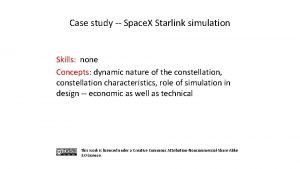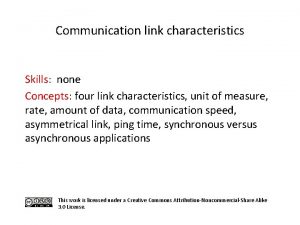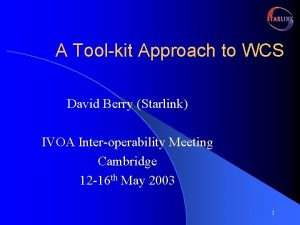Case study Space X Starlink simulation Skills none











- Slides: 11

Case study -- Space. X Starlink simulation Skills: none Concepts: dynamic nature of the constellation, constellation characteristics, role of simulation in design -- economic as well as technical This work is licensed under a Creative Commons Attribution-Noncommercial-Share Alike 3. 0 License.

Where does this topic fit? • Internet concepts • Applications • Technology (communication) • Implications • Internet skills • Application development • Content creation • User skills

Simulation of Space. X Starlink, the initial design • • • 32 orbital planes 50 satellites in each plane Planes are inclined by 53 -degrees 1, 100 km altitude 5 inter-satellite laser links per satellite Clip showing dynamic nature of the constellation Video of the simulation (7 m 54 s)

Simulation of Space. X Starlink, revised design • • • 24 orbital planes 66 satellites in each plane Planes are inclined by 53 -degrees 550 km altitude Four inter-satellite laser links per satellite Video: • Mesh overview clip • Clip showing dynamic nature of the constellation • Full video of the simulation (6 m 46 s)

They decided that the fifth laser link would improve performance, but it would delay the project and not cost too much (for now). How did they arrive at that decision? …

Starlink goal When he opened the Seattle satellite office in 2015, Elon Musk’s goal was to transport "a majority of long-distance Internet traffic … and about 10% of local consumer and business traffic” (clip) Opening of Seattle satellite office. Full Speech Who are the customers for the lucrative long-distance, low-latency routes? Where do they tend to be located?

Simulation of four and fivelink mesh networks Four links per satellite Five links per satellite The four-link design performs worse than the five link, but can be developed faster, costs less and performs better on east-west routes than north-south.

Full Starlink plan for 11, 927 satellites Animation • Red: the initial 1, 584 satellites at 550 km • White: 1, 600 2 nd phase satellites at 1, 110 km • Yellow: 7, 518 3 rd phase satellites at 335 km 345 km • Blue: 1, 225 satellites in polar orbits Space. X has not yet said whether they plan ISLLs between the layers.

Summary

Resources Simulation of One. Web, Space. X and Telesat's proposed global broadband constellations: https: //cis 471. blogspot. com/2019/01/simulation-of-oneweb-spacex-and. html A cool simulation of Space. X's revised satellite broadband plan: https: //cis 471. blogspot. com/2018/11/a-cool-simulation-of-spacexs-revised. html Simulation of the early deployment of the Spacex Starlink: https: //www. youtube. com/watch? v=k 73 AFybi 7 zk Can constellations of Internet routing satellites compete with long-distance terrestrial cables? https: //cis 471. blogspot. com/2017/09/can-constellations-of-internet-routing. html Inter-satellite laser link update https: //cis 471. blogspot. com/2019/09/inter-satellite-laser-link-update. html Track the progress of the Internet-service satellite projects here.

Self-study questions The orbital altitude in the initial design was 1, 100 km and the revised design it was 550 km. 1. Will more power be required for communication between satellites in the initial design or revised design? 2. Which will require more power to communicate between a satellite and the ground? 3. Will the satellites be travelling faster, slower or at the same speed with the initial design or the revised design? 4. In which design will a given satellite be able to cover a larger area on the ground?




















